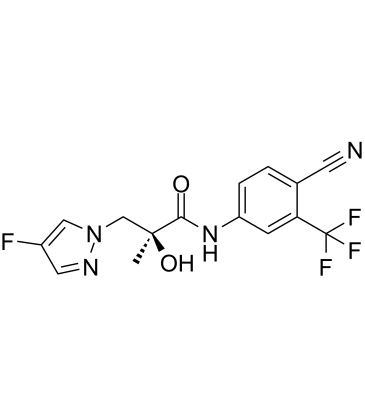| Description |
UT-34 is a potent, selective and orally active second-generation pan-androgen receptor (AR) antagonist and degrader with IC50s of 211.7 nM, 262.4 nM and 215.7 nM for wild-type, F876L and W741L AR, respectively. UT-34 binds to ligand-binding domain (LBD) and function-1 (AF-1) domains and requires ubiquitin proteasome pathway to degrade the AR. UT-34 has anti-prostate cancer efficacy[1][2].
|
| Related Catalog |
|
| Target |
IC50: 211.7 nM (Wild-type AR), 262.4 nM (F876L AR) and 215.7 nM (W741L AR)[1]
|
| In Vitro |
UT-34 (3-10 µM; 24 hours; LNCaP cells) treatment inhibits the expression of PSA and FKBP5 and growth of LNCaP cells starting from 100 nM with maximum effect observed at 10 μM[1]. UT-34 (0.1-10 µM; 24 hours; LNCaP cells) treatment results in a reduction of AR levels at 1000 nM in LNCaP cells[1]. Treatment of ZR-75-1 cells maintained in serum-containing growth medium with UT-34 results in downregulation of AR protein levels, but not estrogen receptor (ER) or progesterone receptor (PR) levels. Furthermore, in MDA-MB-453 breast cancer cells that express AR and glucocorticoid receptor (GR), UT-34 induces the downregulation of AR, but not GR[1]. UT-34 is an effective degrader of both AR and AR-V7. LNCaP-ARV7 cells are treated for 24 hours in the presence of 0.1 nM R1881 or 10 ng/mL Doxycycline. Doxycycline induces the expression of EDN2, which is inhibited by UT-34, while UT-34 inhibits the expression of R1881-induced FKBP5 gene expression[1]. Cell Viability Assay[1] Cell Line: LNCaP cells Concentration: 3 µM, 10 µM Incubation Time: 24 hours Result: Inhibited the expression of PSA and FKBP5 and growth of LNCaP cells starting from 100 nM with maximum effect observed at 10 μM. Western Blot Analysis[1] Cell Line: LNCaP cells Concentration: 0.1 µM, 1 µM, 10 µM Incubation Time: 24 hours Result: Resulted in a reduction of AR levels at 1000 nM.
|
| In Vivo |
UT-34 (20-40 mg/kg; oral administration; daily; for 14 days; NSG mice) at 20 and 40 mg/kg reduces the seminal vesicle weight by 10%-20% and 50%-60 %, respectively[1]. UT-34 inhibits androgen-dependent tissues such as prostate and seminal vesicles in rats, and the growth of Enzalutamide-resistant castration-resistant prostate cancer (CRPC) xenografts. UT-34 also induces tumor regression in intact immunocompromised rats[1]. Animal Model: Non obese diabetic/severe combined immunodeficiency Gamma (NSG) mice injected with MR49F cells[1] Dosage: 20 mg/kg or 40 mg/kg Administration: Oral administration; daily; for 14 days Result: Reduced the seminal vesicle weight.
|
| References |
[1]. Ponnusamy S, et al. Orally Bioavailable Androgen Receptor Degrader, Potential Next-Generation Therapeutic for Enzalutamide-Resistant Prostate Cancer. Clin Cancer Res. 2019 Nov 15;25(22):6764-6780. [2]. Stone L. UT-34: a promising new AR degrader. Nat Rev Urol. 2019 Nov;16(11):640.
|
